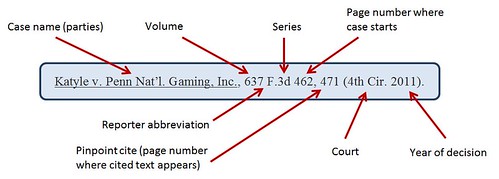What is a Case Citation?

Federal Cases - Examples
B10 (page 11) & Rule 10 (page 95)
U.S. Supreme Court
- Table T1 says to use the official reporter, United States Reports (U.S.) when citing U.S. Supreme Court cases:
- Miranda v. Arizona, 384 U.S. 436 (1966).
- Unofficial reporters
- West's Supreme Court Reporter (S. Ct.)
- Lawyer's Edition (L. Ed.)
- Use unofficial reporters ONLY if the case does not appear in the U.S. Reports
U.S. Courts of Appeals
- Table T1 says to use the Federal Reporter (F., F.2d, F.3d, F.4th) when citing U. S. Courts of Appeals cases:
- Envtl. Def. Fund v. EPA, 465 F.2d 528 (D.C. Cir. 1972).
U.S. District Courts
- Table T1 says to use the Federal Supplement (F. Supp., F. Supp. 2d) when citing U.S. District Court Cases:
- Glover v. Oppleman, 178 F. Supp. 2d 622 (W.D.Va. 2001).
You should never parallel cite (that is have more than one citation) for a federal case.
For additional examples, see the Basic Bluebooking--Case Law in Legal Documents tipsheet, provided courtesy of the Law Library at the Pace Law School.
Virginia Cases - Examples
B10 (page 11) & Rule 10 (page 95)
Supreme Court of Virginia (previously Supreme Court of Appeals)
- Official reporter
- Virginia Reports (Va.). See Virginia entry on Table T1 of the Bluebook when citing reporters for cases from 1880 and earlier.
- Unofficial reporter
- Table T1 says to use the South Eastern Reporter (S.E., S.E.2d) when citing to Supreme Court cases:
- Nolte v. MT Tech. Enters., LLC, 726 S.E.2d 339 (Va. 2012)
- Table T1 says to use the South Eastern Reporter (S.E., S.E.2d) when citing to Supreme Court cases:
Court of Appeals
- Official reporter
- Virginia Court of Appeals Reports (Va. App.)
- Unofficial reporter
- Table T1 says to use the South Eastern Reporter (S.E.2d) when citing to Court of Appeals cases:
- Sapp v. Commonwealth, 546 S.E.2d 245 (Va. Ct. App. 2001).
- Table T1 says to use the South Eastern Reporter (S.E.2d) when citing to Court of Appeals cases:
Circuit Courts
- Unofficial reporter (The Circuit Courts in Virginia are not officially courts of record. The Virginia Circuit Court Opinions are not sanctioned by the state, they are a commercial publication.)
- Virginia Circuit Court Opinions (Va. Cir. Ct.)
- Ticonderoga Farms, Inc. v. Bd. of Supervisors of Loudon Cnty., 72 Va. Cir. 365 (2006).
- Virginia Circuit Court Opinions (Va. Cir. Ct.)
For additional examples, see the Basic Bluebooking--Case Law in Legal Documents tipsheet, provided courtesy of the Law Library at the Pace Law School.
Official v. Unofficial - What is the Difference?
Cases are published electronically and in print in volumes called court reports or case reporters.
- Official reporters are case reporters designated by statute, court rule, or by contract with the government as the official reporter for a particular jurisdiction
- Unofficial reporters are case reporters that are not designated as the official reporter for the jurisdiction they cover. They are not sanctioned by the government.
The text of an opinion should be identical in both the official and unofficial reporter. The only difference between an official and an unofficial reporter is under whose authority the reporter is published. The confusion between official and unofficial reporters may be caused by the fact that the federal government and many states have chosen to have a commercial publisher, Thomson Reuters, to publish the official court reporters for their jurisdiction. Thus, the South Eastern Reporter is the official reporter for the state of West Virginia but the unofficial reporter for the state of Virginia.
Which Reporter Should I Use When Citing a Case?
As law students, follow the Bluebook rules along with any specific guidance from your professor.
For each state, Table T1 (page 227) lists the case reporter you should cite along with its correct abbreviation.
Cases are often published in more than one case reporter. When a case citation includes cites to the same case published in multiple reporters, that is known as a parallel citation. Bluebook Rule 10.3.1(a) (page 103) requires that if a document is being filed in state court and the state court rules require a parallel citation then a parallel citation must be used. It is important to note that both requirements must be met. A parallel citation is never correctly used in an ordinary legal memoranda.
Published v. Unpublished - What is the Difference?
Some cases are not designated for publication by the courts.
"Some courts and legislatures have attempted to control the publication of judicial opinions by limiting publication to those opinions that (1) enunciate a new rule of law or change or modify an existing rule; (2) apply an established rule of law to a new or significantly different fact situation; (3) involve a legal issue of continuing public interest; (4) criticize existing law; (5) resolve an apparent conflict of authority; or (6) contribute to the legal literature by collecting relevant case law or reciting legislative history." [1]
Unpublished cases can be found in various places:
- West's Federal Appendix was a case reporter that printed the unpublished opinions of the U.S. Courts of Appeals. It is no longer published.
- Lexis, Westlaw, Bloomberg Law and other online platforms include unpublished cases in their state and federal case databases.
- Legal newspapers, such as Virginia Lawyers Weekly, selectively publish opinions from unpublished cases.
Use of unpublished cases on the state level is governed by court rules. States differ in allowing citation to use cases. On the federal level, the use of unpublished cases has been allowed since 2007. See Rule 10.8.1 (page 112) for information on pending and unreported cases.
__________________________
[1] Steven M. Barkan et al., Fundamentals of Legal Research 35 (9th ed. 2009).
Short Form Citation
Rule B10.2 (page 16) addresses short form citation of case law. Look at the examples listed as part of rule B4 on page 8.
Rule 4 addresses the use of id. and supra.